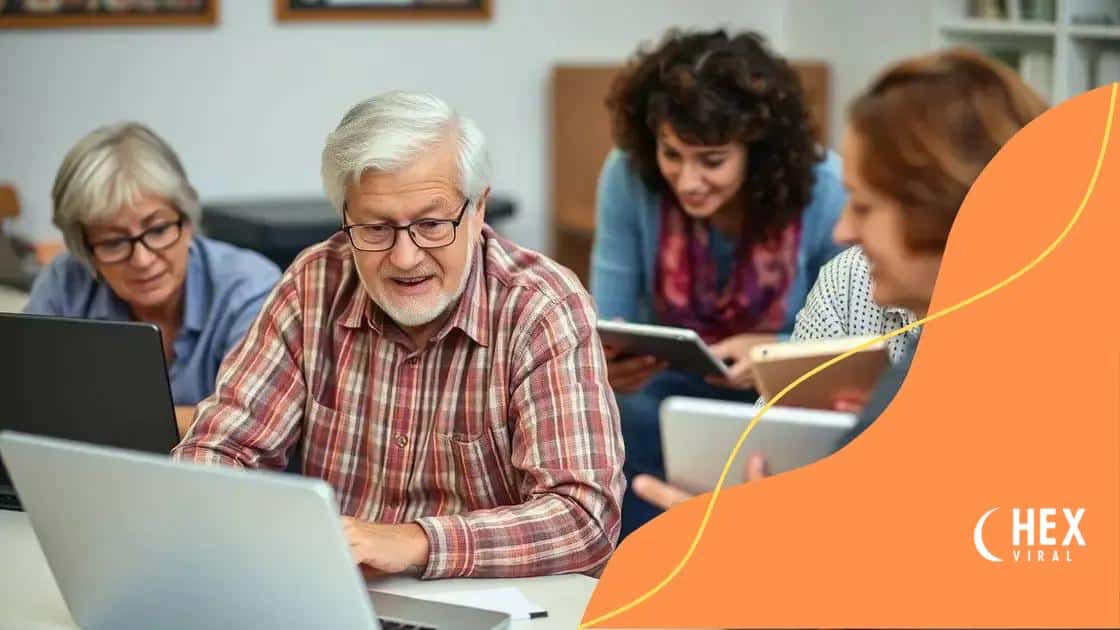Senior citizen digital literacy training made easy

Senior citizen digital literacy training empowers older adults to effectively use technology, enhancing their ability to connect with others, access vital information, and engage in meaningful activities.
Senior citizen digital literacy training opens new doors for the older generation, bridging the gap between them and the fast-paced digital world. Are you curious about how this training can change lives? Let’s explore.
Understanding digital literacy for seniors
Understanding digital literacy for seniors is crucial as technology becomes more integrated into our daily lives. For many older adults, navigating the digital world can be intimidating. It’s essential to recognize that digital literacy is not just about using a computer; it involves understanding the tools and resources available to them.
What is Digital Literacy?
Digital literacy refers to the skills needed to live, learn, and work in a society where communication and access to information increasingly occur via digital technologies. For seniors, this means learning how to use smartphones, tablets, and computers effectively.
Core Skills for Seniors
Here are some core skills that seniors should focus on when improving their digital literacy:
- Basic computer operations: Understanding how to turn on a computer, file management, and using software applications.
- Internet browsing: Knowing how to search effectively online and distinguish between reliable and unreliable sources.
- Email communication: Learning how to send and receive emails, attach files, and manage email accounts.
- Social media use: Understanding how to engage safely on platforms like Facebook or Twitter to connect with family and friends.
These skills empower seniors to connect with their communities and access vital resources. Moreover, it can reduce feelings of isolation by enabling them to communicate with family and enjoy social networks.
By breaking down barriers to technology, we can promote digital literacy among seniors. In community centers, workshops can provide hands-on training that encourages confidence. These sessions can include practical exercises that make learning enjoyable and relatable.
Additionally, involving family members can make a significant difference. Older adults often feel more comfortable learning from younger family members who can offer personalized guidance. This approach not only improves digital literacy but also strengthens family bonds.
Benefits of digital skills for older adults
Digital skills provide numerous benefits for older adults, making everyday life easier and more enjoyable. When seniors become comfortable with technology, they can connect better with family and friends, access information, and even manage their health more effectively.
Enhancing Communication
One of the most notable benefits of digital skills is improved communication. Seniors can use video calling apps like Skype or Zoom to stay in touch with loved ones, breaking the barriers of distance.
Access to Information
The internet offers a wealth of information. Older adults can learn about current events, hobbies, and health topics. They can join forums or online groups that match their interests, which helps them stay informed and engaged.
- Finding reliable health information and resources.
- Participating in online courses to learn new skills.
- Exploring hobbies through Youtube tutorials.
- Reading e-books and articles on various topics.
With digital skills, seniors also gain access to online services that simplify day-to-day tasks. For instance, online shopping or banking becomes easily manageable, saving time and effort. This independence is empowering, allowing them to maintain control over their lives.
Technology also opens up avenues for entertainment. Seniors can watch movies, listen to music, or play games online. These activities contribute not just to leisure, but also to cognitive engagement, keeping their minds sharp.
In summary, having strong digital skills significantly enhances the quality of life for older adults. The confidence gained from learning to use technology can lead to new friendships and social interactions that were previously unavailable. As they adapt to the digital age, they find not only new ways to connect but also new ways to thrive.
Effective training methods for senior citizens

Effective training methods for senior citizens focus on a variety of approaches that cater to their unique learning styles. The goal is to create an environment where they feel comfortable and confident. Hands-on activities can be especially beneficial, making technology approachable.
Interactive Workshops
Hosting interactive workshops allows seniors to learn in a group setting. This encourages communication and sharing of ideas, fostering a supportive atmosphere.
- Small group sessions promote personal attention.
- Real-life scenarios help seniors relate and apply skills.
- Encouraging peer support boosts confidence.
Moreover, using familiar examples can help map out the teaching process. For instance, demonstrating how to set up a video call using a family member’s contact can make learning more relevant. As they see the real-life application, they become more engaged.
One-on-One Tutoring
Pairing seniors with dedicated tutors is another effective strategy. Individualized attention ensures that lessons can be paced according to each person’s needs, making the learning experience more effective.
During these sessions, patience is key. Tutors should use simple language and avoid technical jargon. Breaking down tasks into manageable steps helps seniors retain information better.
Encouraging practice between lessons is also vital. Providing resources like short tutorial videos allows seniors to revisit concepts at their own pace, reinforcing their skills. Offering materials in various formats, such as printed guides and online videos, accommodates different learning preferences.
Using technology that seniors encounter in everyday life makes the training feel applicable. For example, training on smartphones or tablets familiarizes them with tools they are most likely to use.
Ultimately, creating a welcoming and relaxed environment is essential for effective learning. This not only reduces anxiety but also fosters a sense of community among participants. When seniors feel connected, they are more willing to engage in their learning process.
Resources for enhancing digital literacy
Resources for enhancing digital literacy are abundant and can greatly assist seniors in their journey to become more tech-savvy. Accessing the right tools and materials can make a significant difference in their learning experience.
Online Courses
Several platforms offer online courses specifically designed for older adults. Websites like Coursera and Udemy have courses that cover everything from basic computer skills to advanced software use. These courses often feature:
- Video tutorials that allow for step-by-step learning.
- Interactive quizzes to reinforce knowledge.
- Access to instructors for additional help.
Many of these courses are free or low-cost, making them accessible for everyone.
Community Resources
Local libraries and community centers often provide workshops and training sessions. These sessions are led by knowledgeable volunteers or staff members. Learning in a group setting allows seniors to ask questions and share experiences, which promotes collaboration.
Additionally, some organizations focus on helping seniors navigate technology. They might offer:
- In-person tutoring sessions.
- Resource guides tailored for older adults.
- Technology fairs showcasing the latest gadgets and tools.
These community-driven resources are valuable because they foster social interaction and reduce feelings of isolation among participants.
Moreover, various printed materials like user manuals and how-to guides can be incredibly helpful. These documents can serve as references when seniors are performing tasks on their own. It is essential that these resources use straightforward language and clear visuals.
Lastly, leveraging family support can enhance the digital learning experience. Family members can introduce digital tools and apps, making learning more relatable. This hands-on interaction can boost confidence and may even turn learning into a fun, bonding activity.
Success stories of seniors in technology
Success stories of seniors in technology showcase the incredible achievements of older adults who have embraced digital tools. These inspiring examples highlight how technology can change lives and build confidence.
Connecting with Family
Many seniors have successfully used technology to connect with family members. For instance, one grandmother learned to use video calls to stay in touch with her grandchildren. This not only helped her feel more connected but also allowed her to participate in family events and celebrations from afar.
Exploring New Hobbies
Some seniors have taken their newfound digital skills into creative avenues. A retired teacher started an online blog to share her knitting patterns. This not only gave her a sense of purpose but also introduced her to a community of fellow knitters across the globe. She now enjoys virtual meetups and shares her work online.
- Many seniors have joined online art classes to explore painting and photography.
- Some even started YouTube channels to share cooking or gardening tips.
- Learning platforms like Skillshare enable seniors to learn new skills at their own pace.
These activities not only keep seniors mentally engaged but also foster friendships and connections with others who share similar interests.
Advancing with Technology
Another inspiring example is a retired engineer who began volunteering at a local community center, teaching basic computer skills to other seniors. His knowledge and enthusiasm motivated many older adults to learn how to use devices and the internet effectively. The sense of achievement among these learners often leads to greater confidence in their abilities.
These stories illustrate that learning technology is not just about finding the right apps or devices; it’s about creating a supportive environment where seniors feel valued and motivated. Every small success can lead to more significant accomplishments, allowing them to enjoy a more fulfilling life.
Many of these success stories show that age is not a barrier to learning. With the right resources and support, seniors can thrive in the digital age.
In conclusion, enhancing digital literacy among seniors is vital for their independence and connection in this technology-driven world. By providing the right resources and support, we can empower older adults to embrace new tools confidently. Their success stories highlight that age is no barrier to learning, and with patience and encouragement, seniors can thrive in the digital world. As families and communities come together to support these efforts, we pave the way for a brighter, more connected future for everyone.
FAQ – Frequently Asked Questions about Senior Citizen Digital Literacy Training
What are the main benefits of digital literacy for seniors?
Digital literacy helps seniors connect with family, access vital information, and engage in hobbies, enhancing their quality of life.
How can seniors learn digital skills effectively?
Seniors can learn through interactive workshops, one-on-one tutoring, and online courses tailored for their needs.
What resources are available to support senior digital literacy?
Resources include online courses, community workshops, printed guides, and support from family members.
Can learning technology help reduce isolation among seniors?
Yes, technology enables seniors to connect with friends and family, fostering social interaction and reducing feelings of loneliness.






